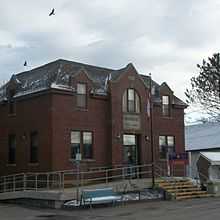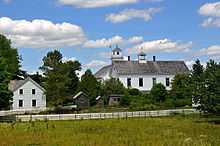Sherbrooke, Nova Scotia

Coordinates: 45°8′26″N 61°59′2″W / 45.14056°N 61.98389°W

Sherbrooke, Nova Scotia (2011 population: 1,395[1]) is a Canadian rural community in Guysborough County, Nova Scotia.
History
Sherbrooke is nestled between Sherbrooke Lake and St. Mary's River. The river was named for Fort Saint Marie, a French-built fort which was later taken over and destroyed by the British, and is renowned for its angling and its run of wild Atlantic salmon. Over the past decades the population of Atlantic salmon has decreased dramatically, and fishing of Atlantic salmon is strictly prohibited, as is catch and release. The famous Babe Ruth came to Sherbrooke many times to fish salmon (when you could). Old pictures of Babe Ruth can be found at Sherbrooke Village in the Boat Shop.
The community takes its name from Sir John Coape Sherbrooke, a colonial era Lieutenant-Governor of Nova Scotia. His name can also be found throughout other communities in Canada. The community in the late 1800s and early 1900s benefited from one of the many gold rushes, as did the surrounding communities. Miners came from all over Canada and the United States to stake a claim in the gold of Wine Harbour, Goldenville, Sherbrooke, and Cochran Hill. Goldenville, being the most popular for miners, was a boom town; previously no bigger than it is today, overnight it boomed to hundreds, probably even thousands of people. Goldenville was named for the gold rush, the brooks running through Goldenville is said to shine of gold. It is also said that only 20% of the gold in this area had actually been taken out, 80% still lying in the ground waiting to be mined. This can be said for all communities in the Sherbrooke area that had gold. The reason there is still 80% of the gold is because during this gold rush, these miners did not have the technology to break up the rock completely to get all of the gold in it. The gold still in the rocks would be sent down brooks where, after being broken apart by the water, it would settle in deposits throughout the brooks. Because of this, panning for gold throughout the area grew considerable over the years, attracting a wide range of people.
Another community that was changed dramatically from the gold rush was Wine Harbour. This community is now about the size of Goldenville, but back during the gold rush it became a boom town too. During the peak of the gold rush, this small community had three main streets (which was big for any community outside of Halifax at this time). There was also a hotel as well as several general stores.
Like any of the gold rushes throughout Canada and the United States, the good times of prosperity ended and the communities that used to be booming towns were soon reduced in size. And so the major employment for the area turned from gold mining to fishing, tourism, and lumber.
Sherbrooke Village

Sherbrooke is famous regionally for being the home of Sherbrooke Village, an open air museum. Sherbrooke Village employs the majority of residents in the area; estimated to around 100 full-time and seasonal workers. There are approximately 30 buildings including include a working blacksmith shop, a pottery shop, a water powered lumber mill (located off site), a tea room (restaurant), and several animal barns (sheep, horses, cow, chickens, turkeys, and peafowl or peacocks). Sherbrooke village is the largest component of the Nova Scotia Museum complex; it open in the summer from June to October and at select times the rest of the year.
In the winter, towards the end of November there is a Christmas tree lighting, called "An Old Fashioned Christmas" that takes place at the head of Sherbrooke and after the tree is lit a walk down the main street of Sherbrooke follows which leads down through Sherbrooke Village towards the ball field. Local groups throughout the St. Mary's Municipality decorate the doors of the buildings in the village, as well a community group decorates the remaining parts of Sherbrooke Village.
St. Mary's River
The St. Mary's River is home to hundreds of different wildlife species, from the smallest insects to the many different predators. The St. Mary's River stretches over 200 kilometres and has three main branches, the east branch, the west branch, and the north branch. The branch feeds into the main river located by Sherbrooke, which then gets transported out to the Atlantic Ocean. The St. Mary's River is home to the famous Atlantic Salmon, but as listed above the no longer allowed to be fished due to its critical population.
The river is also homed to bald eagles which make their home on old dead trees along the St. Mary's River because of the food that await in the water below. If you are lucky, you may get to see one perched on an old tree as you drive along the St. Mary's River. Other common birds to see along the river are the Osprey, Great-horned owls, and a wide range of hawks.
Another resident of the St. Mary's River is the wood turtle, which is a protected species. Surveys have been done along the St.Mary's River to learn the wood turtle population, their diet, habitat, and breeding grounds.
A common species of fish to see in the river and its many estuaries is the Speckled Brook Trout, which as makes its home in sheltered waters and underneath logs that have fallen in the brooks. The brook trout is also a food source for many of the birds along the St. Mary's River.
Life in Sherbrooke
Life in Sherbrooke is like any rural community slow paced. Sherbrooke has several restaurants, a coffee house, a pharmacy, one garage, a gas station, a hairdresser, a hardware store, and a small grocery store. Sherbrooke also has an RCMP station ,a RBC branch and a hospital.
Children and teenagers of the District of St. Mary's attend the school in Sherbrooke: a combined elementary school (grades primary to seven) and grade 8 to grade 12. A new municipal building was completed in 2013.